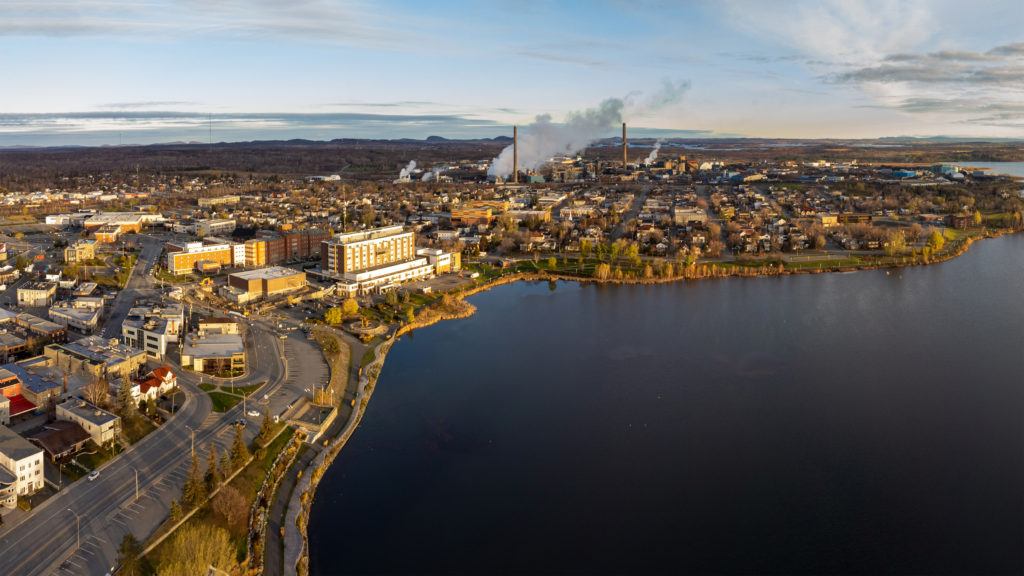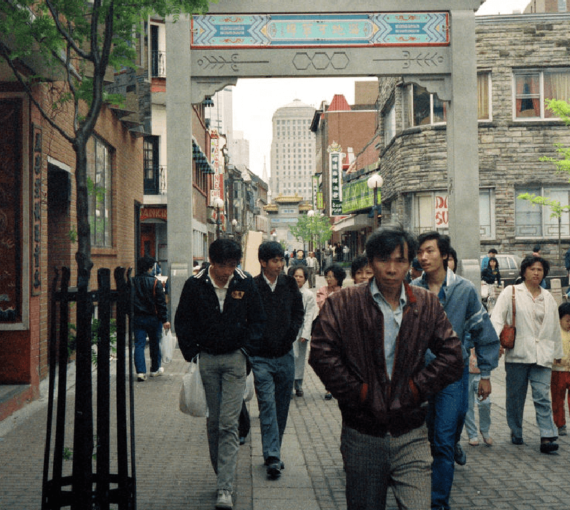
Aerial panoramic view of Rouyn-Noranda City and Osisko Lake on sunset time. Abitibi-Temiscamingue, Quebec, Canada.
Interview with Nicole Desgagnés, member of Stop Toxic Emissions and Waste
Note: This English translation, including quotations, is from a French original.
The City of Rouyn-Noranda is located on the shores of Osisko Lake, in the region of Abitibi-Témiscamingue. Bolstered by raw materials resources, its economy has long been dominated by the Horne Foundry, a copper processing plant owned by the multinational company Glencore. This once peaceful town has been the centre of widespread public attention since a series of revelations regarding chemical poisoning effects on the area’s children spurred a citizen movement to urge government to enact stricter health standards to protect the population.
Nicole Desgagnés, member of Stop Toxic Emissions and Waste, recalled events that led to the group’s creation. In 1979, improvement of plant workers’ conditions after massive employee mobilization coincided with the Office of Toxic Substances Studies, a provincial organization mandated to research the environmental and human health effects of chemical contamination. One study showed Rouyn-Noranda’s residents suffering disproportionately from lead poisoning and a high concentration of sulfur in the air. Following grassroots initiatives pioneered by local residents, the Horne Foundry developed a sulfuric acid factory that recovered 50 per cent (97 per cent today) of sulfur emissions to decrease its pollution index.
Research also revealed that Notre-Dame neighbourhood soil contained abnormally high levels of lead, endangering children’s health. As a remedy, government ordered revitalization of the grounds, covering playgrounds with a thick layer of soil to reduce children’s contact with the contaminated land. The operation was unknown to borough residents, who were never informed of the risks involved.
This once peaceful town has been the centre of widespread public attention since a series of revelations regarding chemical poisoning effects on the area’s children spurred a citizen movement to urge government to enact stricter health standards to protect the population.
In winter 2019, results of a 2018 Public Health Services study on the effects of lead, arsenic and cadmium in approximately 40 children aged two to five in the Notre-Dame neighbourhood were published. Shock and disbelief spread among the community. The study revealed the harmful consequences of lead poisoning on children’s physical and psychological development, ranging from respiratory diseases to lowered intellectual abilities.
Nicole remembers being a “skeptic” when the new study was published. As a former public health professional, she believed information this damning would have been shared with the public a long time ago. “I used to be a nurse and I had never even heard of this,” she said. Her illusions shattered when other previously concealed data about chemical poisoning effects and government inaction were uncovered. In 1982, Public Health Services found that, due to the contamination, Rouyn-Noranda residents faced a higher risk of cancer compared to the general population. In 1993, the federal government issued a notice prescribing regular follow-ups for people with arsenic poisoning. In 2004, the concentration of toxic chemicals reached a peak of 1,000 nanograms — ten times the recommended level. Before 2019, no one in the residential population had this information.
The locals’ growing discontent quickly catalyzed into the creation of a citizen group. Its members are mostly parents and grandparents whose children and grandchildren Public Health Services tested. Allied with former health professionals, they organized educational meetings and door-to-door sessions by making the content of governmental reports understandable for most people. After several weeks of drafting petitions, writing open letters, mobilizing the community to oppose the foundry and hiring experts to contradict the Public Health Services report, government finally instructed the company to draft a plan to decrease the level of toxic chemicals in the air.
In 1982, Public Health Services found that, due to the contamination, Rouyn-Noranda residents faced a higher risk of cancer compared to the general population.
The group remains dissatisfied with the Public Health Services measures. “We want more,” Nicole said, highlighting that Glencore’s suggested solutions — paving the industrial terrain and sweeping the ground more regularly — are “ineloquent and unambitious.” She also denounced government’s refusal to seriously consider the residents’ concerns during a consultation in 2019, explaining that Environment Minister Benoît Charette and Public Health Services director Horacio Arruda behaved in a “paternalistic” manner toward them. After that meeting, Arruda allegedly told his department to withhold the report’s appendix, which contained statistics on the Rouyn-Noranda residents’ high lung cancer risks, triggering a second scandal when a journalist discovered the information.
Although Stop Toxic Emissions and Waste gathered staunch public support, the group’s activism escalated tensions because the foundry provides around 600 jobs. While some foundry employees resigned, Nicole says others still grapple with conflicting interests, torn between their children’s health and a refusal to admit their contribution (although unconscious, indirect and without consent) to a dangerous project. Faced with divergent loyalties, she’s aware that the town’s social fabric is stretched thin, as the foundry’s misinformation campaign can exacerbate hostilities.
The locals’ growing discontent quickly catalyzed into the creation of a citizen group. Its members are mostly parents and grandparents whose children and grandchildren Public Health Services tested.
The group navigates this slippery terrain by offering sustainable solutions to the workers, “who are in the same boat as us” Nicole said. Economic diversification in the fields of education, arts and culture would allow the city to prosper without the foundry, which has long ceased to be Rouyn-Noranda’s main source of revenue.
Striving ahead, Nicole describes her team’s future with optimism. The group aspires to adopt a more assertive approach through further community organizing. Even though the COVID-19 pandemic forced members to temporarily step away from public events, mass mobilization to pressure government to establish stricter air and soil quality norms continues. “We do not address our demands to the foundry, but to Public Health Services,” Nicole said, emphasizing that it’s the government’s responsibility to protecting the population against multinational companies’ greed.
The group aspires to adopt a more assertive approach through further community organizing. Even though the COVID-19 pandemic forced members to temporarily step away from public events, mass mobilization to pressure government to establish stricter air and soil quality norms continues.


